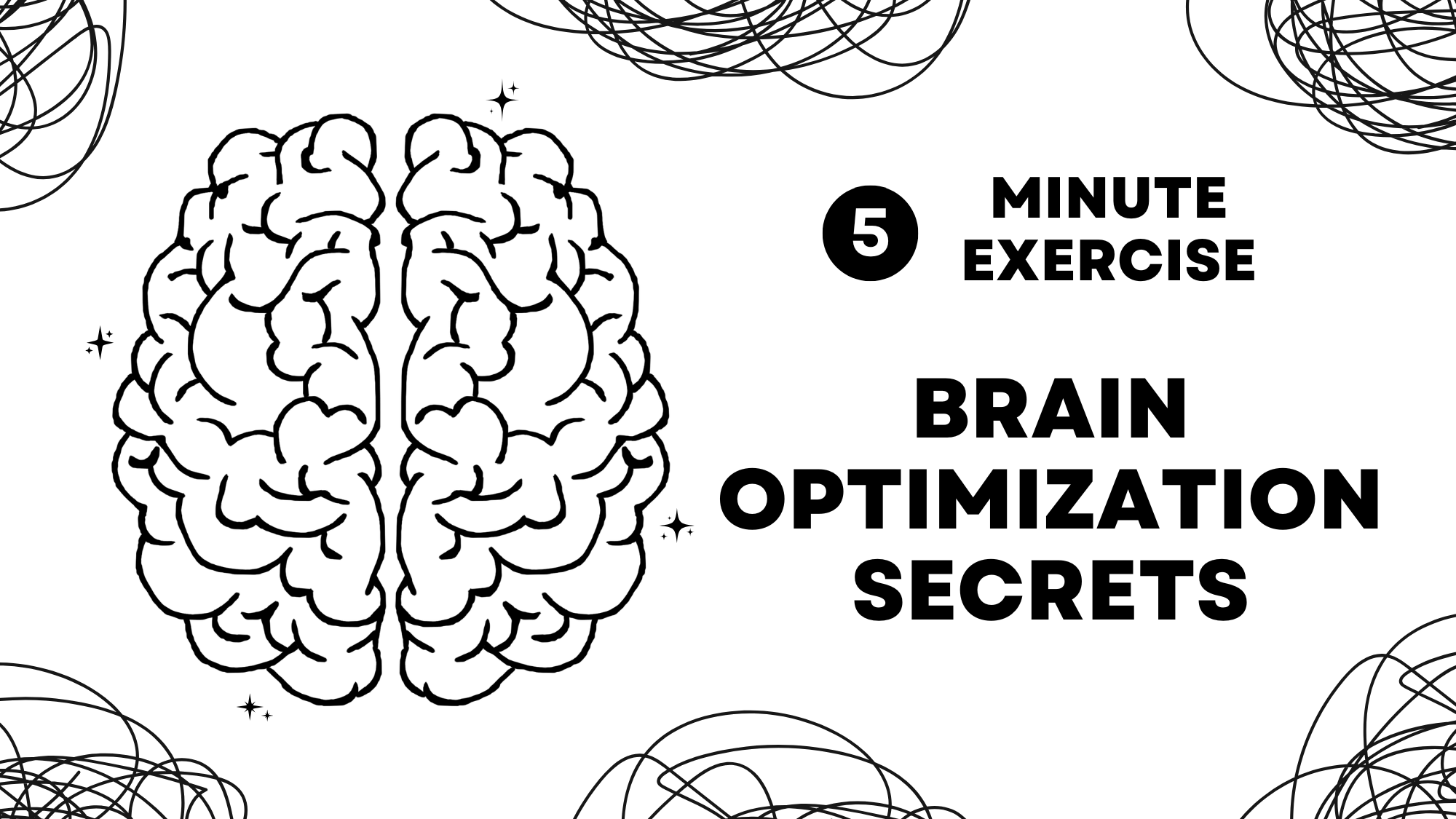Brain Optimization Secrets: The 5-Minute Exercise That Changes Everything
Introduction
Have you ever wondered if you’re tapping into your brain’s full potential? We all have moments when we feel mentally foggy, unfocused, or simply not performing at our best. The good news? There’s a simple, scientifically-backed 5-minute daily activity that can help you unlock your brain’s hidden capabilities. Let’s dive into this transformative practice that’s changing lives worldwide.
Understanding Your Brain’s Potential
Before we reveal this powerful technique, let’s understand something fascinating: scientists estimate that most people only use a fraction of their brain’s true potential. While the “10% of brain use” myth has been debunked, research shows that we can significantly enhance our cognitive abilities through specific practices.
The 5-Minute Brain-Boosting Activity: Mindful Visualization
The game-changing activity I’m about to share is called “Mindful Visualization,” a powerful combination of meditation and active imagination. This practice has roots in both ancient wisdom and modern neuroscience.
How to Practice Mindful Visualization
- Find a Quiet Space (30 seconds)
- Choose a comfortable, distraction-free environment
- Sit or lie down in a relaxed position
- Ensure you won’t be interrupted for the next 5 minutes
- Breathing Reset (1 minute)
- Take three deep breaths
- Inhale through your nose for 4 counts
- Hold for 4 counts
- Exhale through your mouth for 6 counts
- Mental Clearing (30 seconds)
- Close your eyes
- Let go of any immediate concerns
- Focus on the present moment
- Active Visualization (2 minutes)
- Picture yourself achieving your daily goals
- Imagine solving complex problems effortlessly
- Visualize your brain forming new connections
- See yourself performing tasks with enhanced clarity
- Integration Period (1 minute)
- Slowly return to your surroundings
- Take three more deep breaths
- Set an intention for the day
The Science Behind the Magic
Neuroplasticity at Work
This 5-minute practice works by leveraging neuroplasticity – your brain’s ability to form new neural connections throughout life. Research shows that consistent visualization activities can:
- Strengthen neural pathways
- Improve cognitive function
- Enhance memory retention
- Boost creative problem-solving abilities
What the Research Says
Multiple studies have demonstrated the effectiveness of brief mindfulness and visualization practices:
- A 2019 study published in the [Journal of Cognitive Enhancement] showed that participants who practiced similar techniques for just 5 minutes daily showed improved attention spans after 8 weeks.
- Research from Harvard Medical School indicates that regular mindfulness practices can increase gray matter in brain regions associated with learning and memory.
Benefits You’ll Experience
Immediate Benefits
- Enhanced focus and concentration
- Reduced mental fatigue
- Improved mood and emotional balance
- Better stress management
Long-term Benefits
- Increased memory capacity
- Enhanced problem-solving abilities
- Better emotional regulation
- Improved learning capabilities
- Stronger mental resilience
Making It a Habit
Tips for Consistency
- Same Time, Same Place
- Choose a specific time each day
- Designate a particular spot for your practice
- Make it part of your morning or evening routine
- Start Small
- Begin with just 5 minutes
- Don’t pressure yourself to extend the time
- Focus on consistency over duration
- Track Your Progress
- Keep a simple journal
- Note any improvements in your daily life
- Document changes in your cognitive abilities
Common Challenges and Solutions
Challenge 1: “I Don’t Have Time”
Solution: Remember, it’s just 5 minutes. Wake up 5 minutes earlier or use your lunch break.
Challenge 2: “I Can’t Focus”
Solution: Start with shorter sessions and gradually build up. Use guided recordings initially if needed.
Challenge 3: “I Don’t See Results”
Solution: Keep a progress journal and look for subtle improvements. Results often appear gradually.
Real-Life Success Stories
Sarah’s Story
Sarah, a 35-year-old marketing executive, struggled with information overload and decision fatigue. After implementing this 5-minute practice for three months, she reported:
- Improved decision-making ability
- Better memory retention
- Enhanced creative thinking
- Reduced workplace stress
Mark’s Experience
Mark, a 45-year-old teacher, noticed significant improvements in:
- Classroom management
- Lesson planning efficiency
- Student engagement
- Personal stress levels
Enhancing the Practice
Complementary Activities
- Physical Exercise
- Combine with light morning stretching
- Take a short walk afterward
- Practice simple yoga poses
- Healthy Diet
- Stay hydrated
- Eat brain-boosting foods
- Maintain regular meal times
- Quality Sleep
- Maintain a consistent sleep schedule
- Create a relaxing bedtime routine
- Minimize screen time before bed
The Ripple Effect
Professional Impact
- Better work performance
- Enhanced leadership abilities
- Improved communication skills
- Increased productivity
Personal Growth
- Stronger relationships
- Better emotional awareness
- Enhanced self-confidence
- Improved decision-making
Moving Forward
Setting Realistic Expectations
Remember that this practice is not a magic bullet but rather a tool for gradual, sustainable improvement. Consistency is key, and results will vary from person to person.
Creating a Support System
- Share your practice with family and friends
- Join online communities of like-minded individuals
- Consider finding an accountability partner
- Share your experiences and learn from others
Measuring Success
Tracking Progress
- Cognitive Improvements
- Memory capacity
- Problem-solving speed
- Focus duration
- Creative thinking
- Emotional Benefits
- Stress levels
- Emotional stability
- Mood patterns
- Anxiety management
- Physical Changes
- Sleep quality
- Energy levels
- Stress-related symptoms
- Overall well-being
Conclusion
This 5-minute daily practice might seem simple, but its effects can be profound. By consistently engaging in Mindful Visualization, you’re not just improving your cognitive abilities – you’re investing in your future self. Remember, the journey to unlocking your brain’s full potential starts with a single step, or in this case, just 5 minutes of your day.
Frequently Asked Questions (FAQs)
Q1: Can anyone practice this technique?
A: Yes, this technique is suitable for everyone, regardless of age or experience level. It’s particularly effective for adults looking to enhance their cognitive abilities.
Q2: How long before I see results?
A: While some people notice improvements within a few days, significant changes typically become apparent after 3-4 weeks of consistent practice.
Q3: Can I practice multiple times per day?
A: Yes, you can practice this technique 2-3 times daily, but ensure you’re not forcing it. Quality matters more than quantity.
Q4: Do I need any special equipment?
A: No special equipment is needed. Just find a quiet space where you can sit or lie comfortably without interruption.
Q5: Will this help with memory problems?
A: While this practice can support better memory function, consult a healthcare provider for serious memory concerns.
Q6: Can children benefit from this practice?
A: Yes, but the technique should be modified for children’s attention spans and developmental levels.
Q7: What if I fall asleep during practice?
A: Falling asleep occasionally is normal and not a problem. Try practicing at a different time of day if it happens frequently.
Q8: Can this help with anxiety and stress?
A: Many practitioners report reduced anxiety and better stress management, but it shouldn’t replace professional mental health treatment if needed.
Q9: How does this differ from regular meditation?
A: This practice combines meditation with active visualization, making it more targeted for cognitive enhancement than traditional meditation alone.
Q10: Can I practice this while commuting or at work?
A: While possible, it’s best to practice in a quiet, safe environment where you can fully focus without distractions.




